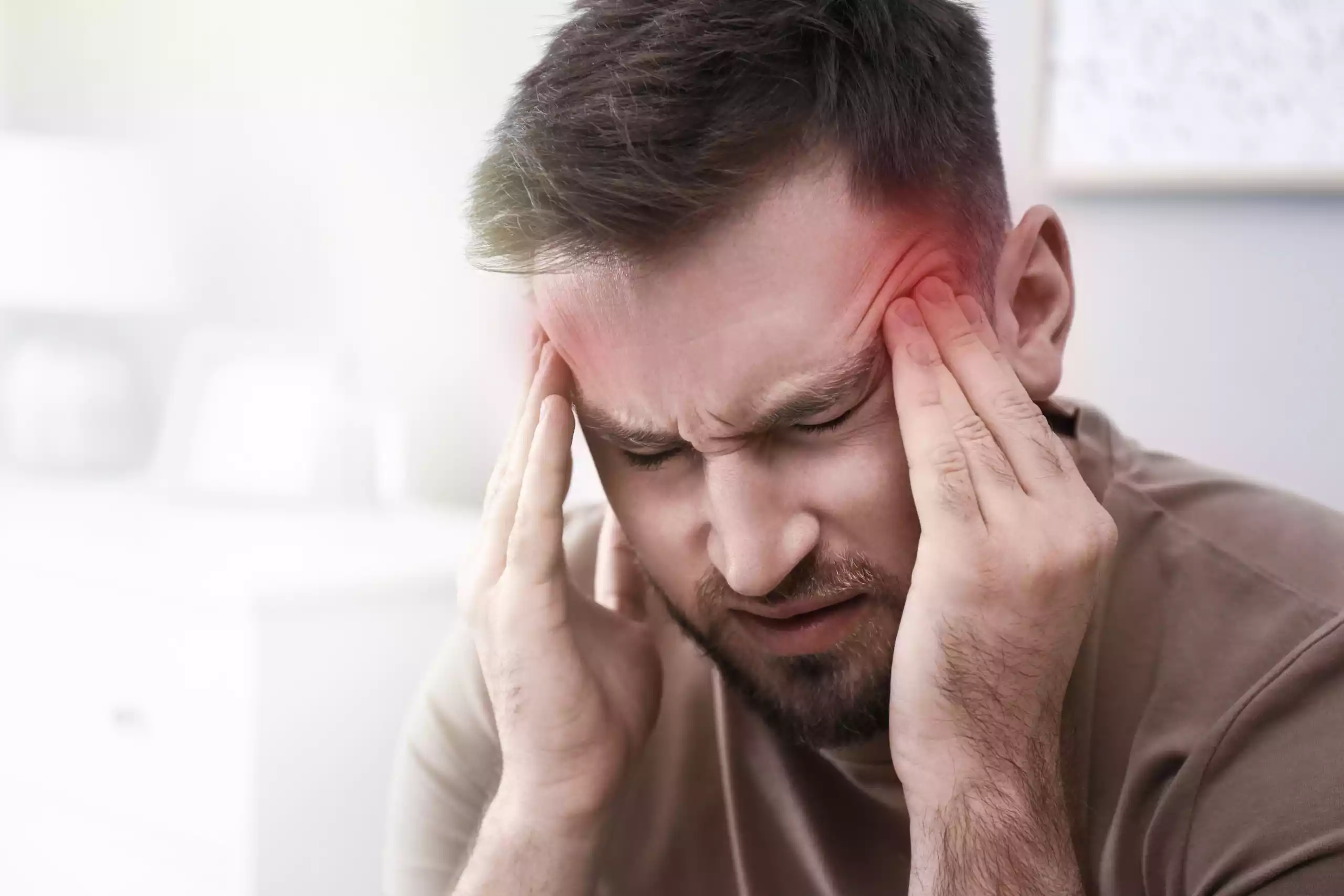Tension Headache and Migraine are two prevalent types of headaches, each with distinct characteristics. A tension headache typically presents as a dull, aching sensation, often described as a tight band encircling the forehead, commonly resulting from stress, anxiety, or muscle strain. Migraines, on the other hand, are intense, throbbing pains usually localized to one side of the head, often accompanied by nausea, sensitivity to light and sound, and sometimes preceded by visual disturbances known as ‘auras’. While both can be disruptive, understanding their differences is crucial for effective management and relief.
Definition of Tension Headache
A Tension headache is the most common type of primary headache disorder. It is often described as a feeling of having a tight band around the head or pressure at the temples or back of the head. The pain is typically bilateral, meaning it’s present on both sides of the head, and is of mild to moderate intensity. Tension headaches are believed to be caused by muscle tension in the head and neck regions, although the precise cause and mechanism remain somewhat unclear.

They can be triggered by factors such as stress, anxiety, poor posture, eye strain, and certain physical activities. Unlike migraines, tension headaches do not typically feature other accompanying symptoms like nausea or light sensitivity. They can be episodic (occurring less than 15 days per month) or chronic (occurring 15 or more days per month).
Causes of Tension Headache
Tension headaches are multifactorial, meaning they can be influenced by a combination of physical and psychological factors. Here are some of the most common causes and triggers:
- Muscle Strain: Prolonged contraction or overuse of muscles in the head, neck, or shoulders can lead to tension headaches. This can result from activities that involve holding the head in one position for extended periods, like using a computer, reading, or other fine work.
- Poor Posture: Sitting or standing with an incorrect posture can strain the muscles of the neck and shoulders, leading to tension headaches.
- Stress: It’s one of the most common triggers. Acute stress or chronic daily life stresses can increase muscle tension and result in a headache.
- Sleep Issues: Lack of sleep, irregular sleep patterns, or sleeping in an unusual position can be associated with tension headaches.
- Eye Strain: Activities that strain the eyes, such as prolonged reading, computer use, or exposure to bright lights, can trigger tension headaches.
- Clenching Jaw: This can be due to stress, anxiety, or a dental problem. Grinding teeth at night, a condition called bruxism, can also result in morning tension headaches.
- Dehydration: Not consuming enough fluids, especially in hot and humid conditions, can lead to a headache.
- Missed Meals: Skipping meals can lead to low blood sugar, which can trigger a headache in some people.
- Certain Activities: Repetitive activities that put strain on the head or neck muscles, such as sewing, knitting, or typing, can be potential triggers.
- Physical Trauma: Injuries, especially whiplash or other neck injuries, can result in persistent tension headaches.
- Other Conditions: Sometimes, tension headaches can be secondary to sinus infections, certain types of eye diseases, or other medical conditions.
- Medications and Drugs: Some medications, especially those taken for high blood pressure, have been associated with tension headaches.
- Hormonal Changes: Fluctuations in hormones, especially around menstruation, pregnancy, or menopause, can be linked with increased frequency of tension headaches in some women.
While these are common causes and triggers, it’s essential to remember that tension headaches can sometimes occur without an identifiable cause. If someone frequently experiences tension headaches or finds them severe or debilitating, they should consult a medical professional to rule out other underlying conditions and get appropriate guidance on management and treatment.
Symptoms of Tension Headache
Tension headaches typically present with a characteristic set of symptoms, making them distinguishable from other headache types, such as migraines. Here are the common symptoms of tension headaches:
- Dull, Aching Pain: Unlike the throbbing nature of migraines, tension headaches usually cause a dull, constant pain.
- Tightness or Pressure: Many sufferers describe it as feeling like they have a tight band around their head. This sensation of tightness or pressure is often most pronounced around the forehead, temples, or back of the head.
- Bilateral Pain: The pain typically affects both sides of the head. It’s usually not localized to one specific area but can be felt all over the head.
- Mild to Moderate Intensity: While the discomfort can be bothersome, the pain is typically mild to moderate, not severe. However, the intensity can vary among individuals.
- Pain in the Neck: Some individuals may also experience tenderness or pain in the neck muscles.
- No Aura or Warning Signs: Unlike migraines, tension headaches don’t have a preceding aura or warning signs.
- Duration: Tension headaches can last anywhere from 30 minutes to a week. If episodic, they can last less than 15 days per month, but if chronic, they occur more frequently, at least 15 days per month for at least three months.
- Absence of Migraine Symptoms: Typically, tension headaches don’t come with the additional symptoms seen in migraines, such as nausea, vomiting, or sensitivity to light and sound. However, light or sound sensitivity can sometimes occur in isolation.
- Not Aggravated by Physical Activity: Unlike migraines, the pain of a tension headache is not made worse by routine physical activity like walking or climbing stairs.
- Scalp Tenderness: Some people might experience sensitivity or tenderness on their scalp, which can be painful to the touch.
While the above symptoms are common to tension headaches, everyone’s experience can differ slightly. If the headaches are recurrent or if the symptoms are severe or unusual, it’s essential to seek a medical evaluation to ensure a correct diagnosis and appropriate treatment.
Definition of Migraine
Migraine is a complex neurological condition primarily characterized by intense, often throbbing headaches that typically affect one side of the head. Unlike regular headaches, migraines can be debilitating and are frequently accompanied by a range of additional symptoms. These can include nausea, vomiting, heightened sensitivity to light and sound, and in some cases, disturbances in vision known as “auras.”

Auras may manifest as flashes of light, zigzagging patterns, or even temporary vision loss. While the exact cause of migraines remains elusive, they are believed to result from abnormal brain activity that affects nerve signals, chemicals, and blood vessels within the brain. Genetic predispositions, environmental factors, and certain triggers, such as stress, hormonal changes, or specific foods, are thought to play significant roles in the onset and progression of this condition.
Causes of Migraine
While the exact cause of migraines is not fully understood, they are believed to be the result of abnormal brain activity causing a temporary alteration in nerve signals, chemicals, and blood flow in the brain. Genetics and environmental factors appear to play a pivotal role. Migraines often occur in response to specific triggers. Some common triggers and predisposing factors include:
- Hormonal Changes: For many women, migraines are linked to their menstrual cycle, making hormonal fluctuations one of the significant triggers. Others may experience migraines during pregnancy or menopause. Hormone replacement therapy and some birth control pills might also trigger migraines.
- Dietary Triggers:
- Aged cheeses
- Caffeine (either too much or withdrawal)
- Salty foods
- Processed foods
- Food additives like aspartame and MSG
- Skipping meals or fasting
- Alcohol, especially wine
- Foods with nitrates like bacon, hot dogs, and deli meats
- Stress: Increased stress or, interestingly, relaxation after a period of high stress can precipitate a migraine.
- Sensory Overstimulation: Bright lights, loud noises, and strong odors (like perfumes, paint, or certain chemicals) can trigger migraines in some people.
- Changes in Sleep Pattern: Either missing sleep, getting too much sleep, or even jet lag can initiate a migraine episode.
- Weather Changes: Changes in barometric pressure, abrupt changes in weather, or changes in altitude can trigger migraines for some individuals.
- Physical Exertion: Intense physical activity, including sexual activity, can induce migraines in some people.
- Medications: Certain medications, including vasodilators and oral contraceptives, can exacerbate migraines.
- Other Factors:
- Dehydration
- High altitude
- Overexertion or physical strain
- Posture issues
- Low blood sugar
- Genetics: People with a family history of migraines are more likely to have them.
- Environmental Factors: These include changes in weather, barometric pressure, or altitude.
- Infections: Sinus infections or other types of infections can sometimes be a migraine trigger.
Triggers can vary greatly from person to person, and not all individuals with migraines will respond to the same triggers. Identifying and understanding personal triggers can play a crucial role in managing and preventing migraine episodes. Many people with migraines find it helpful to maintain a “migraine diary” to track potential triggers and patterns.
Symptoms of Migraine
Migraines are characterized by a variety of symptoms, with the primary symptom being a headache. However, migraines often come with a suite of accompanying features, and the experience can vary among individuals. Here are the common symptoms associated with migraines:
- Headache:
- Typically a throbbing, pulsating pain
- Often unilateral (affecting one side of the head), but can be bilateral
- Intensity can be moderate to severe
- Pain can be aggravated or triggered by physical activity
- Aura: Not everyone with migraines experiences an aura, but for those who do:
- Visual disturbances (flashing lights, zigzag patterns, blind spots)
- Tingling or numbness in the face or extremities
- Speech or language disturbances
- Rarely, partial motor deficits or coordination problems
- Sensory Sensitivities:
- Photophobia (sensitivity to light)
- Phonophobia (sensitivity to sound)
- Osmophobia (sensitivity to smells)
- Nausea and Vomiting: These symptoms can be so severe that the individual may seek a dark, quiet room to lie down.
- Cognitive Changes: Some people report difficulty concentrating, feeling ‘foggy’, or struggling with memory during an attack.
- Mood Changes: It’s not uncommon to experience mood changes, like feeling depressed, anxious, or irritable, during a migraine episode.
- Fatigue and Weakness: Some individuals may feel very tired or lethargic, either during the migraine, after it subsides, or as a warning sign that a migraine is about to occur.
- Neck Pain: Stiffness or discomfort in the neck is frequently reported.
- Dizziness or Vertigo: A sensation of spinning or feeling off-balance can sometimes accompany migraines.
- Visual Changes: Apart from the auras, some people may experience blurred vision or a sensitivity to patterns.
- Frequency and Duration: Migraines can last from 4 hours up to 72 hours if untreated. Some people might experience a migraine only once or twice a year, while others might have attacks several times a month.
- Prodrome Phase: Before the migraine begins, some individuals notice subtle warning signs that a migraine is imminent. These can include mood changes, food cravings, increased thirst and urination, frequent yawning, and neck stiffness.
- Postdrome Phase: After the headache resolves, there’s often a “migraine hangover” where the person can feel drained, fatigued, or even euphoric. Sensitivity to light and sound can continue, and muscle aches or a sense of cognitive slowness can occur.
Migraines are a complex neurological condition with a wide range of symptoms. The experience of a migraine can vary not only among individuals but also from one episode to another in the same individual. If someone suspects they have migraines, it’s essential to seek medical advice for a proper diagnosis and management strategy.
Comparison table of Tension Headache and Migraine
Here’s a comparison table between tension headaches and migraines:
| Feature | Tension Headache | Migraine |
|---|---|---|
| Nature of Pain | Dull, aching, and constant | Throbbing, pulsating |
| Intensity | Mild to moderate | Moderate to severe |
| Duration | 30 minutes to 1 week | 4 to 72 hours if untreated |
| Location | Bilateral (both sides of the head) | Often unilateral (one side of the head) but can be bilateral |
| Associated Symptoms | Typically none | Nausea, vomiting, sensitivity to light, sound, and smells; aura in some cases |
| Physical Activity | Doesn’t usually aggravate pain | Can aggravate pain |
| Frequency | Can be episodic or chronic | Varies widely among sufferers |
| Aura | No | Yes, for some individuals |
| Trigger Factors | Stress, muscle strain, posture, etc. | Dietary triggers, hormonal changes, sensory stimuli, etc. |
| Sensory Sensitivities | Usually absent | Photophobia, phonophobia, osmophobia |
| Neck Pain | Often associated | Less common but can occur |
| Neurological Symptoms | Absent | Present, especially with aura |
| Impact on Daily Activities | Mild to moderate interference | Can be severe, often requiring rest in a dark, quiet room |
While the table provides general distinctions between tension headaches and migraines, individual experiences can vary. Always consult with a healthcare professional for an accurate diagnosis and appropriate treatment.
What are the similarities between Tension Headache and Migraine?
While tension headaches and migraines are distinct in terms of their characteristics and underlying causes, they do share several similarities:
- Nature of Pain: Both are primary headache disorders, meaning they aren’t caused by another underlying medical condition.
- Frequency: Both can occur episodically or chronically. Episodic attacks occur occasionally, while chronic headaches happen more frequently, sometimes even daily.
- Triggers: Both tension headaches and migraines can be triggered by specific factors, such as stress, fatigue, skipping meals, hormonal changes (particularly in women), and certain foods or beverages.
- Response to Environment: For some individuals, bright lights, loud noises, or strong odors can exacerbate both tension headaches and migraines.
- Treatments: Over-the-counter pain relievers like ibuprofen or acetaminophen can be effective for both tension headaches and milder migraines.
- Preventive Measures: Lifestyle changes, such as managing stress, maintaining a regular sleep schedule, staying hydrated, and avoiding known triggers, can help reduce the frequency and severity of both tension headaches and migraines.
- Impact on Daily Life: Both can interfere with daily activities and reduce the quality of life. Chronic or frequent episodes can impact work, social activities, and overall well-being.
- Need for Diagnosis: Proper diagnosis by a healthcare professional is essential for both conditions to ensure appropriate treatment and management.
- Coexistence: It’s possible for an individual to suffer from both tension headaches and migraines, though they will manifest at different times and present distinct symptoms.
- Stress: It’s a significant factor in both conditions. Stress can directly cause tension headaches and can also act as a trigger for migraines.
While tension headaches and migraines have their unique attributes, they share common grounds in terms of triggers, impact on daily life, and some treatment approaches. Recognizing these similarities can aid in understanding the broader spectrum of headache disorders and implementing effective management strategies.
How to diagnosis of Tension Headache and Migraine
Diagnosis of tension headaches and migraines primarily involves a thorough clinical evaluation based on symptoms, history, and excluding other causes of headaches. There is no definitive lab test or imaging study for either condition; instead, it’s about recognizing the characteristic patterns and features.

Here’s how each is typically diagnosed:
Tension Headache:
- Medical History: The healthcare provider will ask about the frequency, duration, location, and type of pain. They’ll want to know about associated symptoms, factors that relieve or aggravate the headache, and any medications taken.
- Physical Examination: A physical examination, including checking for muscle tenderness and assessing neurological function, is essential. In tension headaches, the neurological examination is usually normal.
- Diagnostic Criteria: The International Headache Society has established criteria for diagnosing tension-type headaches. These criteria include:
- Headache frequency less than 15 days per month (for episodic tension headaches) or more than 15 days per month for at least three months (for chronic tension headaches).
- At least two of the following characteristics: pressing or tightening pain, bilateral location, mild-to-moderate intensity, and not aggravated by routine activity.
- No more than one of the following: nausea, light sensitivity, or sound sensitivity.
- Exclusion of Other Conditions: It’s crucial to rule out other causes of headaches, like migraines, sinusitis, or more severe conditions.
Migraine:
- Medical History: Detailed questions about the headache’s nature, associated symptoms (like aura, nausea, and sensitivity to light or sound), triggering factors, and family history of migraines.
- Physical Examination: To check for signs of other conditions that could be causing the headaches.
- Diagnostic Criteria: According to the International Headache Society’s criteria, migraines are typically diagnosed if:
- They have had at least five attacks that last 4 to 72 hours.
- The headache has at least two of the following qualities: unilateral location, pulsating quality, moderate-to-severe intensity, or aggravation by routine physical activity.
- During the headache, at least one of the following is present: nausea and/or vomiting, sensitivity to light and sound.
- Neurological Examination: Although often normal in people with migraines, this helps rule out other neurological conditions that might be causing the headaches.
- Imaging: While not typically required for a migraine diagnosis, imaging tests like MRI or CT scans may be ordered if there’s a suspicion of any underlying condition, or if the pattern of headaches changes, or if the headaches suddenly become more severe.
- Exclusion of Other Conditions: Like with tension headaches, ruling out other causes is essential.
For both conditions, it can be beneficial for patients to maintain a headache diary, noting the frequency, triggers, characteristics, and duration of their headaches. This can provide invaluable information to healthcare providers.
Treatments and Remedies
Both tension headaches and migraines can benefit from a mix of medical treatments and home remedies. Let’s explore these in detail:
Tension Headache:
Medical Treatments:
- Pain Relievers: Common over-the-counter options include aspirin, ibuprofen, and acetaminophen.
- Prescription Medications: For those that don’t respond to OTC treatments or have chronic tension headaches:
- Muscle relaxants.
- Stronger NSAIDs.
- Certain antidepressants, such as amitriptyline.
Home Remedies and Lifestyle Changes:
- Rest and Relaxation: Sometimes, a short period of rest in a quiet, dark room can help.
- Cold or Warm Compress: Placed on the forehead or back of the neck.
- Regular Physical Activity: Helps in reducing the frequency and severity.
- Stress Management: Techniques like deep breathing, meditation, and progressive muscle relaxation can be effective.
- Limit Caffeine: Excess caffeine can trigger or worsen headaches.
- Maintain Regular Sleep Patterns: Ensure you get adequate and consistent sleep.
Migraine:
Medical Treatments:
- Pain Relievers: OTC options like aspirin, ibuprofen, and naproxen sodium can help with milder migraines.
- Triptans: Migraine-specific medications, such as sumatriptan and rizatriptan.
- Ergotamines: Like Cafergot.
- Anti-nausea medications: Metoclopramide or prochlorperazine.
- Preventive Medications: Including beta-blockers, certain antidepressants, Botox injections, and antiseizure medications.
- CGRP inhibitors: Newer class of drugs like erenumab, fremanezumab, and galcanezumab.
Home Remedies and Lifestyle Changes:
- Rest in a Quiet, Dark Room: Sensitivity to light and sound is common in migraines.
- Cold Compress: Applying it to the forehead can provide relief.
- Caffeine: Some people find relief from migraines with beverages like coffee.
- Stay Hydrated: Dehydration can be a migraine trigger.
- Dietary Awareness: Avoiding foods that trigger migraines (like aged cheeses, chocolate, and foods containing MSG).
- Biofeedback and Relaxation Techniques: These can help in managing the triggers and symptoms.
- Maintain a Migraine Diary: Tracking the onset of migraines, triggers, and effective treatments can help in managing and predicting migraines.
For both tension headaches and migraines, it’s essential to work with a healthcare professional to determine the most effective and safe treatment regimen. While some of these remedies and treatments can provide relief, understanding the underlying triggers and causes is crucial for effective long-term management.
Prevention and Lifestyle Changes
Preventing tension headaches and migraines often requires a combination of medical interventions and lifestyle changes. Recognizing and avoiding triggers, along with certain habits and practices, can significantly reduce the frequency and severity of headaches.
Tension Headache
Prevention:
- Stress Management: Regular relaxation techniques like meditation, deep breathing exercises, and progressive muscle relaxation can help manage stress.
- Regular Exercise: Physical activity can help reduce the frequency and severity of tension headaches. Ensure it’s consistent and suited to your fitness level.
- Ergonomics: Proper posture and an ergonomic workstation can help if long hours at a desk are triggering headaches.
Lifestyle Changes:
- Limit Caffeine and Alcohol: Excessive intake can trigger tension headaches for some people.
- Regular Sleep Routine: Keeping a consistent sleep schedule and ensuring you get enough rest.
- Breaks: If you work at a computer, take short breaks every hour to stretch and rest your eyes.
- Stay Hydrated: Drink plenty of water throughout the day.
- Balanced Diet: Ensure you’re getting the right nutrients and avoid skipping meals.
Migraine
Prevention:
- Avoid Known Triggers: These can include certain foods, smells, or stimuli. A headache diary can help identify these.
- Regular Sleep: Too little, too much, or irregular sleep patterns can trigger migraines.
- Medications: If migraines are frequent, preventive medications might be prescribed.
- Hormonal Strategies: For women whose migraines are linked to their menstrual cycle, hormonal treatments or adjustments in birth control methods might help.
Lifestyle Changes:
- Dietary Awareness: Be aware of common food triggers, such as chocolate, wine, processed meats, MSG, and aged cheeses.
- Regular Physical Activity: Helps in reducing the frequency and severity of migraines.
- Limit Stimulants: Reducing intake of caffeine and other stimulants can help some individuals.
- Stress Management: Regular relaxation practices, including yoga, meditation, and deep-breathing exercises, can help manage stress.
- Limit Screen Time: For some, too much time in front of screens can be a trigger.
- Stay Hydrated: Drink plenty of water, and be cautious with alcohol as it can lead to dehydration.
- Consistent Routine: Keeping a regular routine, including mealtimes and wake times, can help.
Both tension headaches and migraines can benefit from a proactive approach to prevention. Regular check-ins with a healthcare provider can help adjust strategies as needed, ensuring the most effective management.
Final Opinion
Tension headaches and migraines, though both common forms of headaches, possess distinct characteristics, causes, and symptoms. While tension headaches generally manifest as a dull, aching pain across the head, migraines tend to be more severe and pulsating, often accompanied by a range of other symptoms like nausea and sensitivity to light or sound.
The underlying causes for each can vary from stress and posture issues for tension headaches to genetic factors and specific triggers for migraines. Despite these differences, both conditions can significantly benefit from tailored treatments, preventive strategies, and lifestyle adjustments. Regular consultations with healthcare professionals are essential to diagnose accurately, manage effectively, and improve overall quality of life for those affected.



